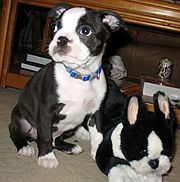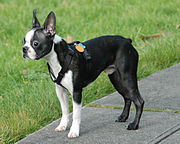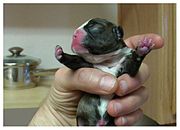
Boston Terrier
About this schools Wikipedia selection
SOS Children volunteers helped choose articles and made other curriculum material Before you decide about sponsoring a child, why not learn about different sponsorship charities first?
 |
|||||||||||||||||||||||||
| Boston Terrier with brindle coat | |||||||||||||||||||||||||
| Other names | Boston Bull Boston Bull & Terrier Boxwood |
||||||||||||||||||||||||
|---|---|---|---|---|---|---|---|---|---|---|---|---|---|---|---|---|---|---|---|---|---|---|---|---|---|
| Country of origin | United States | ||||||||||||||||||||||||
|
|||||||||||||||||||||||||
|
|||||||||||||||||||||||||
| Dog (Canis lupus familiaris) | |||||||||||||||||||||||||
The Boston Terrier is a breed of dog originating in the United States of America.
Description
Appearance
Frequently, variations on the standard are seen depending on the ancestry of the individual dog. At various times, the Bulldog, American Pit Bull Terrier, English Mastiff, Staffordshire Bull Terrier, and French Bulldog—among other breeds—have been crossbred with Boston Terrier lines to minimize inbreeding in what is necessarily a small gene pool.
Size
Boston Terriers are typically small, compactly built, well proportioned dogs with erect ears, short tails, and a short muzzle that should be free of wrinkles. They usually have a square sort of face. According to international breed standard, the dog should weigh no less than 10 pounds and no more than 25 pounds. Boston Terriers usually stand 15-17 inches at the withers.
Coat and colour
The Boston Terrier is characteristically marked with white in proportion to either black, brindle, seal, or a combination of the three. Seal is a color specifically used to describe Boston Terriers and is defined as a black color with red highlights when viewed in the sun or bright light. If all other qualities are identical, brindle is the preferred colour according to most breed standards.
Ideally, white should cover its chest, muzzle, band around the neck, half way up the forelegs, up to the hocks on the rear legs, and a white blaze between but not touching the eyes. For conformation showing, symmetrical markings are preferred. Due to the Boston Terrier's markings resembling formal wear, in addition to its refined and pleasant personality, the breed is commonly referred to as the "American Gentleman."
Temperament
Boston Terriers are mainly hyper, friendly, and rambunctious dogs. They have very strong, lovable, unforgettable personalities. They need owners that can keep up with the alert, loud temperament of this dog. Bostons can range in temperaments from those that are eager to please their master to those that are more stubborn. Both can be easily trained given a patient and assertive owner.
While originally bred for fighting, they were later down bred for companionship. The modern Boston Terrier can be gentle, alert, expressive, and well-mannered. Many still retain the spunky attitude of the typical terrier. Be aware of much dominance, especially toward other dogs and domesticated animals. It must be noted however, that they are not considered terriers by the American Kennel Club, but are part of the non-sporting group. Boston Terrier is something of a misnomer. They were originally a cross-breed between the Old English Bulldog and the English White Terrier. Both of these breeds are now extinct.
Some Bostons enjoy having another one for companionship. Both females and males generally bark only when necessary. Having been bred as a companion dog, they enjoy being around people, and, if properly socialized, get along well with children, the elderly, other canines, and non-canine pets. Some Boston Terriers are very cuddly, while others are more independent.
Health
Several health issues are of concern in the Boston Terrier: cataracts (both juvenile and adult type), cherry eye, luxating patellas, deafness, heart murmur, and allergies. Curvature of the back, called roaching, might be caused by patella problems with the rear legs, which in turn causes the dog to lean forward onto the forelegs. This might also just be a structural fault with little consequence to the dog. Many Bostons cannot tolerate excessive heat and also extremely cold weather, due to the shortened muzzle, so hot or cold weather combined with demanding exercise can bring harm to a Boston Terrier. A sensitive digestive system is also typical of the Boston Terrier. In the absence of proper diet, flatulence is associated with the breed (which is very stinky like Koharu).
Bostons, along with Pug, Pekingese, Shih Tzu and other short-snouted breeds are Brachycephalic breeds. The word comes from Greek roots "Brachy," meaning short and "cephalic," meaning head. This anatomy can cause tiny nostrils, long palates and a narrow trachea. Because of this, Bostons may be prone to snoring and reverse sneeze, a rapid and repeated forced inhalation through the nose, accompanied by snorting or gagging sounds used to clear the palate of mucus. Bostons are also prone to sensitive stomachs and intestinal gas.
They can live up to 15 years or more, with an average of around 13 years.
History
The Boston Terrier breed originated around 1870, when Robert C. Hooper of Boston purchased a dog known as Hooper's Judge, who was of a Bull and Terrier type lineage. Judge's specific lineage is unknown, however, Hooper's Judge is either directly related to the original Bull and Terrier breeds of the 1700s and early 1800s, or Judge is the result of modern English Bulldog's being crossed into terrier's created in the 1860s for show purposes, like the White English Terrier.
Judge weighed over 29.7 pounds (13.5 kilos). Their offspring interbred with one or more French Bulldogs, providing the foundation for the Boston Terrier. Bred down in size from pit-fighting dogs of the Bull and Terrier types, the Boston Terrier originally weighed up to 44 pounds (20 kg.) (Olde Boston Bulldogge). The breed was first shown in Boston in 1870. By 1889 the breed had become sufficiently popular in Boston that fanciers formed the American Bull Terrier Club, but this proposed name for the breed was not well received by the Bull Terrier Fanciers. The breed's nickname, "roundheads", was similarly inappropriate. Shortly after, at the suggestion of James Watson (a noted writer and authority), the club changed its name to the Boston Terrier Club and in 1893 it was admitted to membership in the American Kennel Club. In 1893, the American Kennel Club (AKC) admitted the Boston Terrier breed and gave the club membership status, making it the first US breed to be recognized. It is one of a small number of breeds to have originated in the United States. The Boston Terrier was the first non-sporting dog bred in the US.
In the early years, the color and markings were not very important, but by the 1900s the breed's distinctive markings and colour were written into the standard, becoming an essential feature. Terrier only in name, the Boston Terrier has lost most of its ruthless desire for mayhem, preferring the company of humans, although some males will still challenge other dogs if they feel their territory is being invaded.
Boston Terriers were particularly popular during the 1920s in the US.





